Using evening lamp therapy can greatly improve your sleep quality. By introducing red light into your nighttime routine, you boost melatonin production, helping you fall asleep faster. This therapy counters the blue light from screens that disrupts your sleep cycle. Aim for a session about 30 minutes before bedtime for ideal results. Combine this with a cool, dark bedroom and relaxation techniques for the best experience. With regular practice, you'll notice deeper and more rejuvenating sleep. If you're curious about how to seamlessly integrate this into your life, you might find some helpful insights.
Understanding Melatonin Production
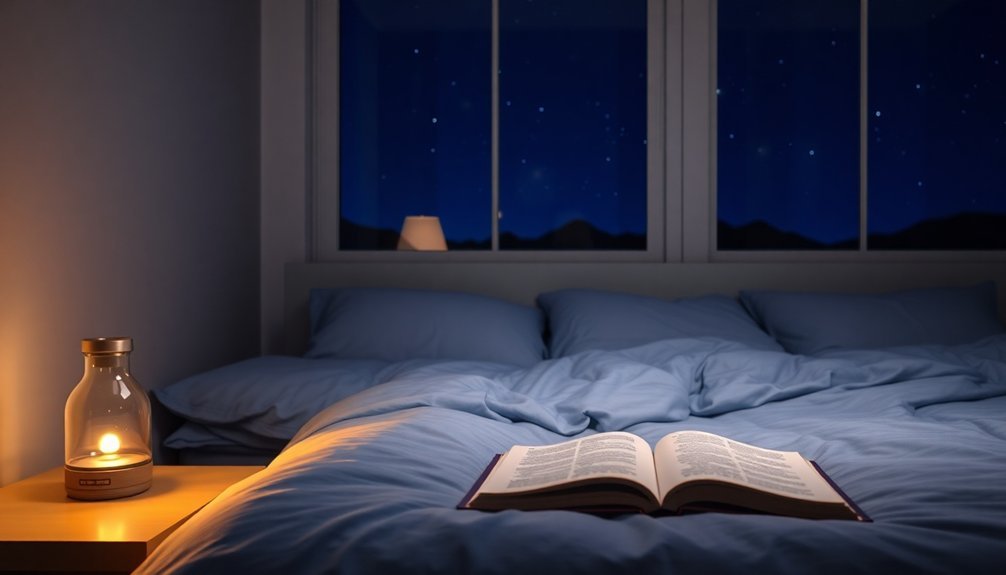
Melatonin production is essential for regulating your sleep-wake cycle and ensuring restful sleep. It all starts with L-tryptophan, an amino acid you can get from protein-rich foods like turkey, chicken, and bananas. This amino acid is first transformed into 5-hydroxytryptophan (5-HTP) and then into serotonin, a significant neurotransmitter that helps stabilize your mood.
From serotonin, the process continues as it's converted into N-acetylserotonin using acetyl-CoA. But that's not where it ends. The ultimate step in this pathway involves methylation of N-acetylserotonin to produce melatonin, aided by specific enzymes. Melatonin is produced by the pineal gland in response to the environmental light-dark cycle, highlighting the importance of light exposure in its regulation.
To optimize your melatonin levels, be mindful of dietary factors. Vitamins B3, B6, B12, and minerals like calcium and magnesium play essential roles. Limiting exposure to bright lights, particularly in the evening, allows your body to kickstart melatonin production when night falls.
Regular sleep patterns and reduced nighttime exercise can also enhance melatonin synthesis. Finally, be aware that factors such as aging and certain health conditions can interfere with this essential hormone's levels, impacting your sleep quality.
The Science of Red Light Therapy
If you're looking to enhance your sleep quality, red light therapy might be a game changer. This innovative technique has shown remarkable benefits for sleep, effectively improving the overall quality of your rest. Red light helps increase your total sleep time by an average of 34 minutes per night, enabling you to fall asleep quicker and wake up less frequently. Additionally, studies indicate that red light therapy can help mitigate symptoms of anxiety, providing a calmer state conducive to restful sleep.
Here's a quick overview of the science behind red light therapy:
| Benefit | Mechanism | Impact |
|---|---|---|
| Improves Sleep Quality | Promotes melatonin secretion | Enhances total sleep duration |
| Reduces Stress and Pain | Lowers cortisol, raises endorphins | Aids in falling and staying asleep |
| Regulates Circadian Rhythms | Supports internal clock | Synchronizes sleep patterns |
| Clinical Evidence & Safety | Non-invasive and drug-free | Improves alertness post-sleep |
How Evening Light Affects Sleep
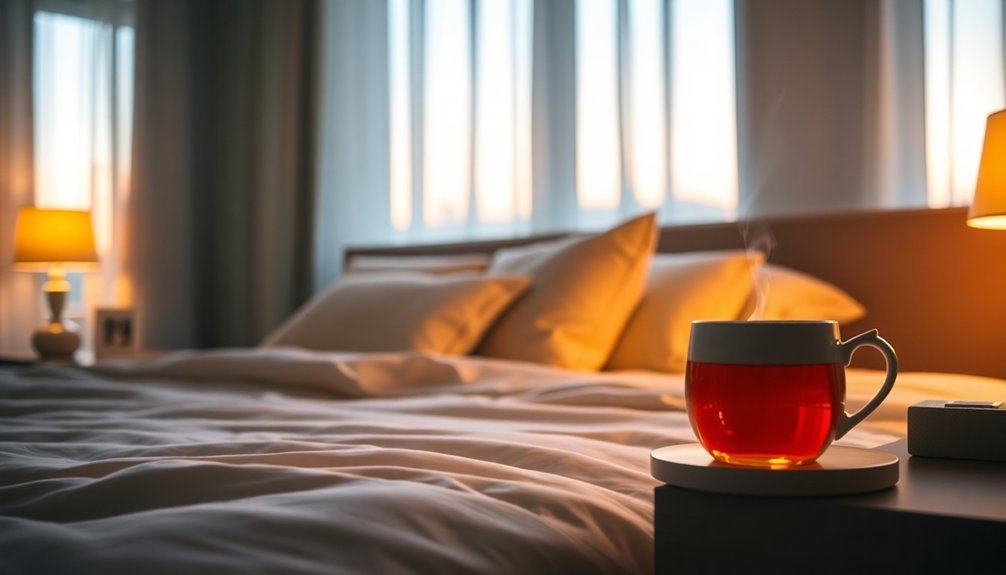
Evening light plays a significant role in how well you sleep, influencing both the quality and duration of your rest. Exposure to light in the evening can suppress melatonin secretion, which is essential for sleep initiation. Blue light, in particular, has a potent effect, disrupting your circadian rhythms even at low levels. This disruption can lead to phase delays in your sleep-wake cycle, affecting when you feel sleepy and when you wake up. Blue light has the most powerful effect on the sleep-wake internal body clock among all colors of light.
While some evening light exposure might improve sleep quality and duration for shift workers, it generally hampers your ability to fall and stay asleep. If you spend the last 30 minutes of your day surrounded by bright light, you may find it takes longer to drift off. Conversely, using dim red lights for nighttime activities can minimize disruption to your sleep.
Moreover, consistently exposing yourself to light during the night increases the risk of health issues, including metabolic disorders and cardiovascular problems. As a result, to protect your sleep and overall health, it's wise to limit evening light exposure and embrace strategies like using blue-blocking glasses or avoiding bright screens before bed.
Optimal Times for Evening Use
To make the most of your evening lamp therapy, timing is key.
Using red light about 30 minutes before bed can really help reset your circadian rhythm and enhance relaxation.
Establishing a consistent routine won't only signal your brain to wind down but also improve your overall sleep quality.
Best Evening Routines
Creating the right evening routine can greatly improve your sleep quality, setting the stage for a restful night. To optimize your evenings, aim for a consistent bedtime, allowing for 7-9 hours of sleep. Stick to this routine even on weekends to help regulate your internal clock.
Begin winding down 30 minutes to 2 hours before bed by following these practices:
- Practice relaxation: Engage in deep breathing exercises, gentle yoga, or meditation to relieve stress.
- Prepare your environment: Make sure your bedroom is cool, dark, and quiet, using blackout curtains and essential oils.
- Focus on mental wind-down: Read a calming book or journal to clear your mind of worries.
Also, limit screen time and avoid electronics at least an hour before bed. This practice helps reduce blue light exposure, allowing your body to naturally prepare for sleep.
Circadian Rhythm Reset
Your evening routine plays a considerable role in managing your circadian rhythm. To effectively reset your internal clock, it's essential to use bright light strategically in the evening. The best times for exposure are between 8 PM and midnight. This timing can help delay melatonin production and extend your total sleep time by over an hour.
Here's a helpful guide to optimize your evening lamp therapy:
| Time Frame | Effect |
|---|---|
| 2000 – 2100 hours | Delays melatonin production by over an hour |
| 2100 – 2200 hours | Markedly shifts temperature rhythm |
| 2200 – 2300 hours | Maximizes total sleep duration |
| 2300 – 2400 hours | Enhances overall sleep quality |
Combining bright white or blue-enriched light exposure during these hours, particularly before your core body temperature minimum, yields the best results. Remember, the more you limit prior light exposure, the greater the benefits from evening light therapy. This targeted approach not only assists with early morning awakenings but also aligns your sleep-wake cycles for healthier rest.
Safety Tips for Light Therapy
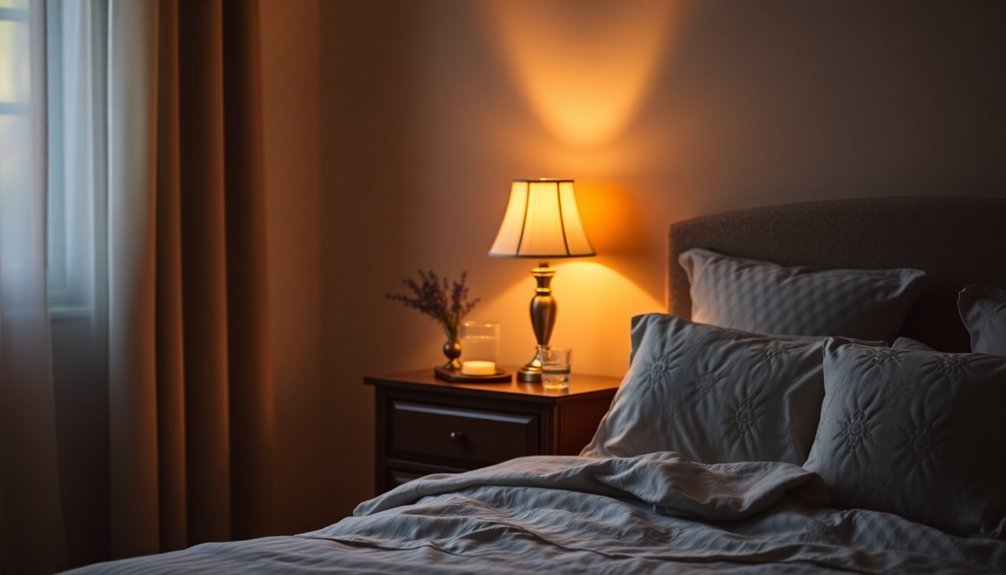
Light therapy can be an effective tool for improving sleep, but safety should always come first. Before starting any light therapy, it's crucial to evaluate several key precautions.
First, check for any contraindications, especially if you're taking medication or have existing health conditions. For example, avoid light therapy if you're on steroid treatment, have skin growths that may be cancerous, or suffer from conditions like epilepsy.
Here are some important safety tips to keep in mind:
- Always wear medical-grade eye protection, including goggles or shields, to prevent damage.
- Position the light therapy device 16-24 inches away from your face and verify it emits indirect light.
- Consult a healthcare provider if you experience persistent side effects like headaches or skin irritation.
Following these guidelines helps minimize potential risks associated with light therapy.
Always read the instruction manual of your device carefully, maintain a clean face before treatment, and avoid sun exposure for a few days after treatment.
Prioritizing safety will allow you to enjoy the benefits of light therapy while keeping your health in check.
Benefits Beyond Better Sleep
Using evening lamp therapy doesn't just help you sleep better; it also enhances your mood and cognitive function.
By mimicking natural light, this therapy can boost your mental well-being and clarity, making daily tasks easier.
You'll find that regulating your circadian rhythms can lead to benefits far beyond just catching more Z's.
Enhanced Mood Regulation
Experience a significant boost in your mood with evening lamp therapy, as it offers benefits that extend well beyond just better sleep. Regular exposure to bright light can help regulate your circadian rhythms, synchronizing your body with the natural daylight cycle. This synchronization enhances your overall well-being and mood, making you feel more energized and vibrant.
Here are some key benefits:
- Improved Serotonin Levels: Light therapy elevates serotonin, a neurotransmitter linked to feelings of happiness.
- Depression Relief: It can alleviate depressive symptoms, sometimes matching the effectiveness of antidepressants, particularly in those with Seasonal Affective Disorder (SAD).
- Reduced Anxiety: By improving sleep quality and promoting relaxation, light therapy helps ease anxiety symptoms.
With consistent use, evening lamp therapy can delay melatonin production, waking you up and naturally lifting your mood. You'll notice fewer mood disturbances and an overall enhancement in your quality of life.
This simple practice can make a world of difference, especially during seasons when daylight is scarce. Embrace evening lamp therapy for a more balanced and uplifting mood!
Increased Cognitive Function
Releasing better sleep isn't the only perk of evening lamp therapy; it can also greatly boost your cognitive function. By helping to regulate your circadian clock, evening lamp therapy enhances overall mental clarity and well-being.
When you're exposed to bright light in the morning, you'll often notice an increase in alertness and a reduction in daytime sleepiness, both of which elevate your cognitive performance throughout the day.
Moreover, as the therapy mimics natural sunlight, it helps maintain normal brain chemistry and hormonal activity, ultimately enhancing focus, motivation, and energy levels. These aspects lead to significant improvements in how your brain functions.
If you've experienced mild traumatic brain injury (TBI), using morning bright light therapy can be particularly beneficial. It not only improves sleep quality but also impacts brain activation during cognitive tasks, assisting your cognitive recovery.
Even for those living with dementia, light therapy can improve cognitive function and mood while synchronizing circadian rhythms.
Managing Side Effects Effectively
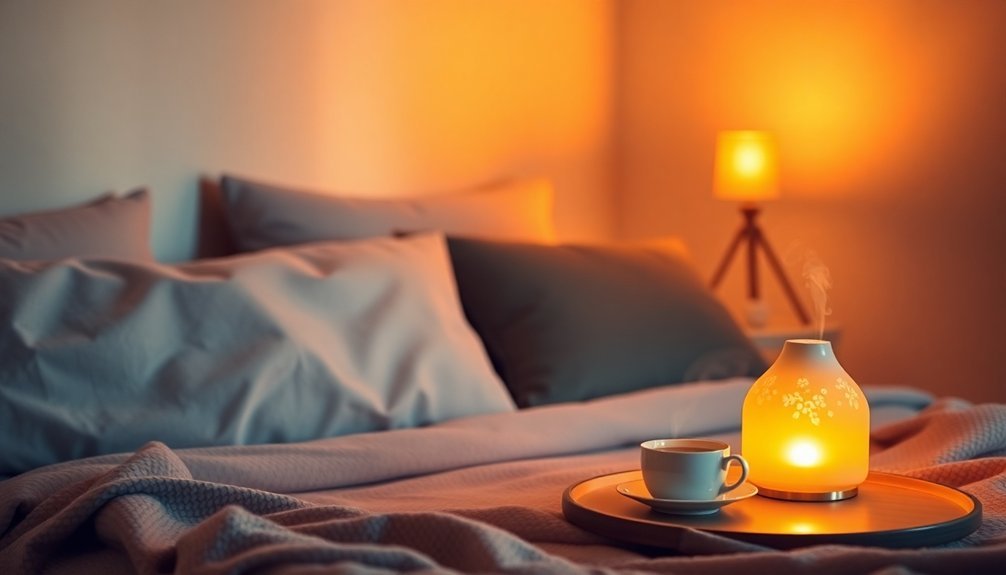
Managing side effects effectively is key to maximizing the benefits of evening lamp therapy. You might encounter common side effects, such as headaches, eye strain, or even mild irritability. Fortunately, most of these issues tend to resolve with time or adjustments in your therapy routine.
To help minimize side effects, consider the following tips:
- Avoid evening sessions: Using light therapy during the day can help prevent sleep disturbances.
- Adjust your setup: Experiment with the duration, intensity, and distance from your light box to find what works best for you.
- Consult a professional: If side effects persist, a doctor or sleep specialist can provide valuable guidance and adjust your treatment plan if necessary.
Keep in mind that while some individuals may experience discomfort, these side effects are usually mild and temporary. Most people find that their body adapts to the therapy within a few days.
Integrating Therapy Into Daily Life
Integrating therapy into your daily life can greatly enhance the overall effectiveness of evening lamp therapy. Start with small, manageable steps—devote 5-10 minutes to mindfulness exercises like deep breathing or journaling.
Next, set aside dedicated times each day for these practices, treating them as important appointments. Use technology to your advantage: set reminders through apps or alarms to maintain consistency.
Establish a structured schedule by defining your therapy goals, whether it's managing anxiety or improving self-esteem. Block out non-negotiable time slots in your planner to prioritize these sessions.
Remember to separate therapy time from work and personal life to create a focused atmosphere.
Enhance your self-awareness by practicing self-compassion and reflecting on your progress through journaling or gratitude practices. This can help anchor therapy to your emotional journey.
Leverage technology further by using therapy apps for mindfulness or mood tracking. You can even incorporate light therapy while engaging in daily activities like reading or working.
Frequently Asked Questions
Can I Use My Regular Ceiling Light for Therapy?
You shouldn't use your regular ceiling light for therapy. It doesn't emit the right intensity or spectrum needed to influence your circadian rhythms effectively and may even cause eye strain or discomfort. Stick to certified therapy lamps instead.
How Long Does It Take to Feel the Effects of Evening Therapy?
You'll typically see effects of evening therapy within a few days to a couple of weeks. Consistent exposure is essential, as benefits may take longer to fully manifest, often around two weeks or more.
Is There an Ideal Distance From the Lamp for Optimal Results?
To achieve ideal results with a light therapy lamp, you should sit 16 to 24 inches away. Experiment with different distances to find what feels comfortable while ensuring the light shines indirectly into your eyes.
Can Light Therapy Improve Mood or Just Sleep Quality?
Light therapy can improve both mood and sleep quality. By boosting serotonin levels, it enhances your mood while also regulating your circadian rhythms, leading to better sleep patterns and a more positive mental state overall.
What Should I Do if I Feel Anxious During Therapy Sessions?
If you feel anxious during therapy sessions, practice grounding exercises, take breaks, and communicate your feelings. You can also focus on deep breathing and establish personal boundaries to help manage your emotions effectively.
In Summary
Embracing evening lamp therapy can truly transform your sleep routine and overall well-being. By understanding how light affects melatonin production, you'll be better equipped to harness its benefits. Remember to use red light in the ideal time frame for the best results. As you integrate this practice into your evenings, you'll likely notice not just improved sleep but also enhanced mood and energy during the day. So, why wait? Access the restful nights you deserve starting tonight!

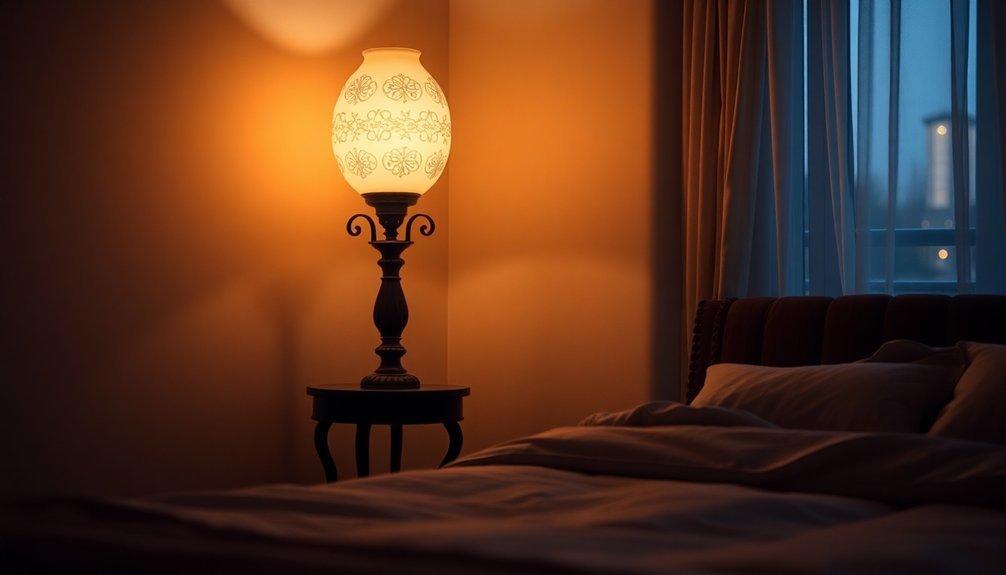



Leave a Reply